Cordycepin kills Mycobacterium tuberculosis through hijacking the bacterial adenosine kinase
- PMID: 31199855
- PMCID: PMC6568415
- DOI: 10.1371/journal.pone.0218449
Cordycepin kills Mycobacterium tuberculosis through hijacking the bacterial adenosine kinase
Abstract
Cordycepin is an efficient component of Cordyceps spp, a traditional Chinese medicine widely used for healthcare in China, and has been recently acted as a strong anticancer agent for clinic. However, whether and how it may play a role in combating tuberculosis, caused by Mycobacterium tuberculosis, remains unknown. Here we report that cordycepin can kill Mycobacterium by hijacking the bacterial adenosine kinase (AdoK), a purine salvage enzyme responsible for the phosphorylation of adenosine (Ado) to adenosine monophosphate (AMP). We show that cordycepin is a poor AdoK substrate but it competitively inhibits the catalytic activity of AdoK for adenosine phosphorylation. Cordycepin does not affect the activity of the human adenosine kinase (hAdoK), whereas hAdoK phosphorylates cordycepin to produce a new monophosphate derivative. Co-use of cordycepin and deoxycoformycin, an inhibitor of adenosine deaminase (ADD), more efficiently kills M. bovis and M. tuberculosis. The add-deleted mycobacterium is more sensitive to cordycepin. This study characterized cordycepin as a new mycobactericidal compound and also uncovered a potential anti-mycobacterial mechanism.
Conflict of interest statement
The authors have declared that no competing interests exist.
Figures
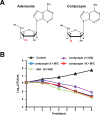

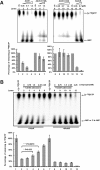
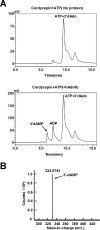
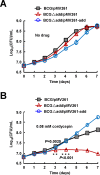
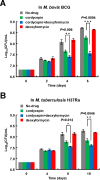
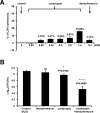

Similar articles
-
Evaluation of 3-deaza-adenosine analogues as ligands for adenosine kinase and inhibitors of Mycobacterium tuberculosis growth.J Antimicrob Chemother. 2007 Jan;59(1):118-21. doi: 10.1093/jac/dkl448. Epub 2006 Nov 3. J Antimicrob Chemother. 2007. PMID: 17085766
-
Structure-activity relationship for nucleoside analogs as inhibitors or substrates of adenosine kinase from Mycobacterium tuberculosis. I. Modifications to the adenine moiety.Biochem Pharmacol. 2006 Jun 14;71(12):1671-82. doi: 10.1016/j.bcp.2006.03.006. Epub 2006 Mar 10. Biochem Pharmacol. 2006. PMID: 16620788
-
Verification of In Vitro Anticancer Activity and Bioactive Compounds in Cordyceps Militaris-Infused Sweet Potato Shochu Spirits.Molecules. 2024 May 3;29(9):2119. doi: 10.3390/molecules29092119. Molecules. 2024. PMID: 38731610 Free PMC article.
-
Anticancer and antimetastatic effects of cordycepin, an active component of Cordyceps sinensis.J Pharmacol Sci. 2015 Jan;127(1):53-6. doi: 10.1016/j.jphs.2014.09.001. Epub 2014 Oct 2. J Pharmacol Sci. 2015. PMID: 25704018 Review.
-
The Anticancer Properties of Cordycepin and Their Underlying Mechanisms.Int J Mol Sci. 2018 Oct 4;19(10):3027. doi: 10.3390/ijms19103027. Int J Mol Sci. 2018. PMID: 30287757 Free PMC article. Review.
Cited by
-
Advances in Key Drug Target Identification and New Drug Development for Tuberculosis.Biomed Res Int. 2022 Feb 25;2022:5099312. doi: 10.1155/2022/5099312. eCollection 2022. Biomed Res Int. 2022. PMID: 35252448 Free PMC article. Review.
-
Cordycepin affects Streptococcus mutans biofilm and interferes with its metabolism.BMC Oral Health. 2025 Jan 4;25(1):25. doi: 10.1186/s12903-024-05355-7. BMC Oral Health. 2025. PMID: 39755609 Free PMC article.
-
Effects of Acremonium terricola Culture on Lactation Performance, Immune Function, Antioxidant Capacity, and Intestinal Flora of Sows.Antioxidants (Basel). 2024 Aug 9;13(8):970. doi: 10.3390/antiox13080970. Antioxidants (Basel). 2024. PMID: 39199216 Free PMC article.
-
Acremonium terricola Culture's Dose-Response Effects on Lactational Performance, Antioxidant Capacity, and Ruminal Characteristics in Holstein Dairy Cows.Antioxidants (Basel). 2022 Jan 17;11(1):175. doi: 10.3390/antiox11010175. Antioxidants (Basel). 2022. PMID: 35052679 Free PMC article.
-
Immunopharmacological Insights into Cordyceps spp.: Harnessing Therapeutic Potential for Sepsis.Curr Pharm Des. 2025;31(11):823-842. doi: 10.2174/0113816128326301240920040036. Curr Pharm Des. 2025. PMID: 39694962 Review.
References
-
- World Health Organization. Global Tuberculosis Report 2018. WHO; 2017.
-
- Cunningham KG, Manson W, Spring FS, Hutchinson SA. Cordycepin, a metabolic product isolated from cultures of Cordyceps militaris (Linn.) Link. Nature 1950;166:949. - PubMed
-
- Zhou XX, Meyer CU, Schmidtke P, Zepp F. Effect of cordycepin on interleukin-10 production of human peripheral blood mononuclear cells. Eur J Pharmacol 2002;453:309–317. - PubMed
-
- Nakamura K, Yoshikawa N, Yamaguchi Y, Kagota S, Shinozuka K, Kunitomo M. Antitumor effect of cordycepin (3’-deoxyadenosine) on mouse melanoma and lung carcinoma cells involves adenosine A3 receptor stimulation. Anticancer Res 2006;26:43–47. - PubMed
Publication types
MeSH terms
Substances
LinkOut - more resources
Full Text Sources
Research Materials
Miscellaneous

